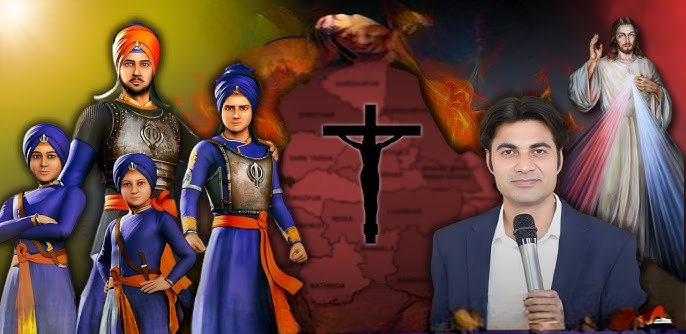Turbaned boys dancing on Yeshu di Balle Balle during Shaheedi Jod Mela. How sickening is it that Sikhs are dancing to Yeshu di Balle Balle after being converted to Christianity during the solemn observance of Chaar Sahibzade Shaheedi. From December 25 to December 30, Sikhs and Hindus mourn the ultimate sacrifice of the four sons of Shri Guru Gobind Singh Ji, who laid down their lives to uphold their faith and resist tyranny.
This is a time of introspection and prayer, which was during the Shaheedi Jodmela, but the celebration of a Christian song by converted Sikhs has left many in pain and questioning the loss of Sikh values. The Chaar Sahibzade represent dauntless and unyielding tenacity to safeguard faith and heritage. Their martyrdom is held sacred by all of Punjab.
On such a day that’s likely to be devoted to mourning these martyrs, however, stands out jarringly Yeshu di Balle Balle, a huge internet hit by Deepak Johnson, son of an “embraced” Christian. The manner in which converted Sikhs participated gullibly in advancing the song indicates a rift brewing with their spiritual as well as cultural heritage.
This disturbing trend is part of a larger problem—increasing rate of conversions of people to Christianity in Punjab. While often encouraged by monetary incentives, promises of miracles, and promises of visas to the Western world, such conversions are changing the demographic and cultural character of the state. What was once a tiny minority of 1.3% of Punjab’s population in the 2011 Census has now surged to 15%, according to recent surveys.
It is said that in districts like Gurdaspur and Hoshiarpur, entire villages have become Christians and are called the “Church Belt.
“The trend was alarming and made worse by the failure of institutions such as the Shiromani Gurdwara Parbandhak Committee (SGPC) and Sikh leadership to check it. Such so-called “apostles” and pastors were found to dupe vulnerable communities, specifically the Dalits, Valmiki Hindus, and Mazhabi Sikhs, using staged miracles, cures, and promises to relieve burdens of financial expenses. With their aspirations of finding easy opportunities outside, the Punjabi youth prove to be susceptible to these schemes by luring them with easy procedures for a visa if they converted.
At a time when people are busy celebrating Yeshu di Balle Balle, the importance of Chaar Sahibzade Shaheedi is forgotten, which raises a very deep crisis in the spiritual and cultural identity of Punjab. As this trend is being followed increasingly, it questions the benefit of preserving Sikh martyrs’ legacy and rich traditions of Punjab in the face of religious conversion and cultural transformation.

